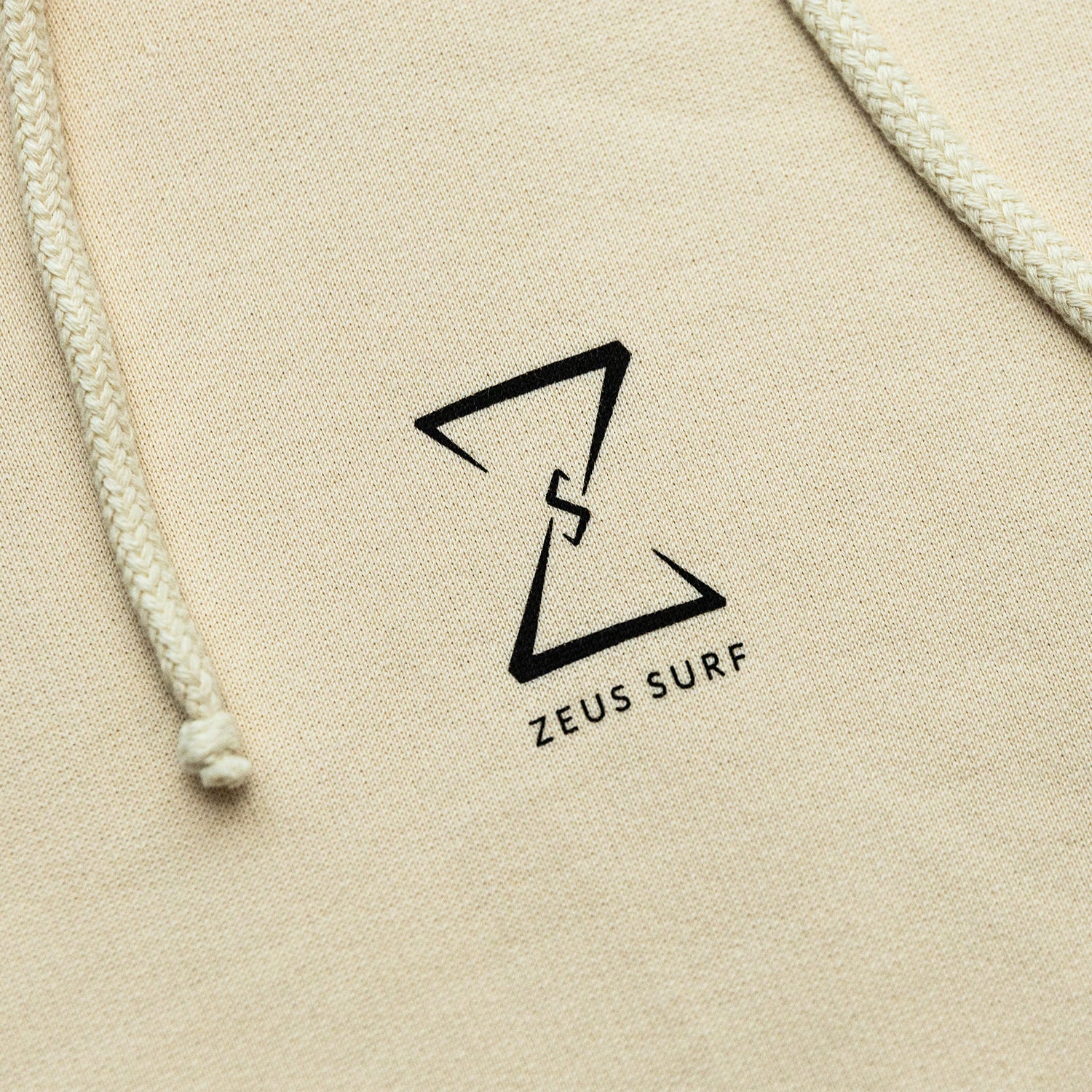What type of surfboard should I use to start with?
Imagine putting on your favorite sneakers for a run... but in a wave version! Just like you wouldn't choose high heels for a basketball game, your first surfboard should be perfectly suited to your level, style, and size.
Shortboard, longboard, funboard… The list reads like a menu of exotic ice creams, but don’t panic! At Zeus, we’ll help you find your ideal board – the one that will give you confidence, stability and, above all, stars in your eyes!
🚨 Beginner trap alert: No, your idol's ultra-light shortboard will NOT turn you into a pro in 2 sessions...
Whether you're a complete beginner or have already caught a few waves, this guide will give you all the keys to making the right choice.
Our smart quiz analyzes your profile and recommends the perfect board in just a few clicks. It's fast, accurate, and personalized!

🎯 The Essentials to Remember
The Ideal Board for Beginners:
- Minimum 7'0" in length
- Foam construction (softboard)
- Type: longboard, funboard or mini-malibu
The 2 Fatal Mistakes to Avoid:
- ❌ Choosing a shortboard that is too technical
- ❌ Opt for a fragile resin board
The 4 Key Criteria:
- 👉 Level: beginner to advanced
- 👉 Template: weight and size
- 👉 Shape: adapt to your style
- 👉 Material: choose so-called softboards.
Our Top Tip: Start with a foam board for added stability, buoyancy, and safety. It's the best choice for rapid progress!

Step One: Define Your Surfing Level
If you just started surfing less than 6 months ago:
If you are a beginner surfer, if you have never surfed or only surfed a few times. Generally, you have just done your first surfing course in a surf school or in a surf camp .
- You're going to need a surfboard that's both stable and easy to maneuver.
- This first board will allow you to learn the basics of surfing in complete safety.
- Choose a board with good buoyancy and generous volume to make it easier to learn how to paddle and catch waves (Take off).
- Foam surfboards are especially recommended for beginners due to their high buoyancy , stability and tolerance for errors . They are easy to handle and allow you to glide without much effort.
In addition to that, they are also safer. They are also affordable surfboards and easy to find on the second-hand market .
For an intermediate surfer:
You are an intermediate surfer if you have gained some surfing experience and are able to paddle, catch waves and perform basic turns.
The goal? To improve your technical skills and feel more comfortable in the water.
An intermediate surfer can begin exploring different board shapes, depending on their preferences and surfing style. The size and volume of the board can be adjusted based on your progress and personal goals. At this stage, you can try more complex maneuvers .
For riders with an advanced level:
You are an advanced surfer if you have solid surfing experience and are proficient in different surfing techniques, maneuvers, and styles. You are able to surf different types of waves and adapt to changing conditions. You likely have preferences when it comes to board shape and performance . They may choose boards that suit their specific surfing style, whether it's shortboards for radical performance, fish boards for smaller waves, or mini-malibus boards for soft waves.
To help you make your choice and find the ideal board easily, all our boards are classified by level .
The advice in this article is aimed at beginner surfers who want to buy their first surfboard to progress.

Resin board VS foam board
Choosing your surfboard is an important choice, as it can have a significant impact on your surfing experience . If you choose the right board, you'll be more likely to progress and enjoy your time in the water.
Foam boards are ideal for beginners. They are more stable and easier to maneuver than composite boards, making them perfect for learning to surf . They are also safer and more resistant to impacts.
Composite boards perform better than softboards. They are faster , more responsive , and allow for more complex maneuvers. However, they are more difficult to learn and require a certain level of skill.
Foam boards or “softboards”
Foam surfboards are made from polyurethane or polystyrene foam, making them more stable and easier to maneuver than traditional resin boards. They are also lighter, making them easier to transport and handle.
These features make them the ideal choice for beginners, who can focus on learning the basics of surfing without worrying about the stability of their board. Foam boards are also popular with experienced surfers looking for a safer experience, especially in the event of collisions with other surfers or the board itself.
Composite boards
Composite surfboards are made from polyurethane or polystyrene foam, then covered with fiberglass and epoxy or polyester resin. This construction gives them superior rigidity and performance to foam boards.
Composite boards are valued for their flexibility and ability to generate speed. They are also thinner than foam boards, making them more maneuverable and better suited to radical maneuvers.
These features make it the ideal choice for experienced surfers looking for a more technical and high-performance feel in the water.
Foam board advantages and disadvantages:
Foam boards are very stable and allow beginners to focus on learning the basics of surfing without worrying about falling. For example, a beginner can learn to paddle, catch waves, and perform basic turns without worrying about losing balance on their board.
The advantages of softboards for beginners
- High Stability: Foam boards are known for their high stability, making them a great choice for beginners looking to learn to surf with confidence.
- Error tolerance: Beginners can make technical mistakes without worrying as much about the consequences, as foam boards absorb impacts more easily than composite boards.
- Greater Safety: Due to their soft design and shock-absorbing ability, foam boards reduce the risk of injury, making them an ideal choice for learning.
Disadvantages of foam boards / softboards 🛑:
- Limited in performance: Foam boards have limited performance compared to composite boards. They are not designed for radical maneuvers or deeper waves.
- Relative durability: Although more durable than resin boards, foam boards can wear out more quickly with heavy use and
- Limits to progression: Once the surfer has acquired advanced skills, he may feel that foam boards no longer meet his performance needs.
Resin Surfboards Pros and Cons
Advantages of composite boards ✅:
- Advanced Performance: Composite boards offer better responsiveness and dynamics in the water, making them ideal for experienced surfers who want to push their limits.
- Technical maneuvers and precision: Thanks to their slimmer design and ability to generate speed, composite boards allow surfers to perform more technical maneuvers and tighter turns.
- Increased Durability: Composite materials, such as fiberglass and epoxy resin, give these boards greater durability compared to foam boards.
Disadvantages of composite boards:
- More difficult to learn: Due to their higher performance, composite boards can be more difficult for beginners to master, which can lead to frustration.
- Less tolerance for errors: Technical errors can have more pronounced consequences on composite boards, which can make learning more abrupt.
- Less suitable for beginners: Due to their thinner design and increased performance, composite boards may not be the best option for beginner surfers looking for a more stable and secure experience.
In short, if you're a beginner, choose a foam board. It will allow you to progress safely and confidently.
If you are an experienced surfer, choose a composite board if you are looking for extreme performance.

Step 3: Size and volume of the board: the essential criteria.
The length of your board will largely determine how easy it is to paddle , how stable you are on the water, and how well you can catch waves . The larger and more voluminous a board is, the more stable and easier it is to use.
In the surfing world, board length is expressed in feet, not centimeters. If you're confused about dimensions, you can check out our surfboard size chart and find our equivalent board models.
Consider your weight and height
Your weight and height are important factors to consider when choosing the size and volume of your board. If you're heavier and taller, you'll need a board with more volume to support you in the water. A wider, thicker board will provide the necessary buoyancy to help you catch waves more easily.
On the other hand, if you are lighter and smaller, you can opt for a board with a little less volume, which will give you better maneuverability and a more dynamic surfing experience.
Be careful not to buy too small when you're starting out: you can choose a board that's at least 7' long. The most common sizes are 7'0, 7'6 and 8'0.
A tip for choosing the right volume for a beginner:
It is best to start with a board whose volume matches the surfer's weight. For example, an 80 kg surfer might choose a 75L board.
For the heavier ones we have developed a range of specific surfboards: the Burger and Big Burger .
These foam boards allow those weighing over 100 kilos to surf with suitable equipment.
Also consider local wave types
Local surf conditions can also play a role in deciding your first board size. Depending on the type of waves at your surf spot , you can choose a board with more or less volume.
- If the waves are very hollow and powerful, then in this case you can take a board with a little less volume.
- On the other hand, if you are on soft waves, it will be better to have more volume to take better advantage of these conditions.
- If you have hollow waves, you can then take a board with a little less volume, provided you have perfect control of the take off.
Please note: the surfer's height and weight should always be considered first before making adjustments to the surf spot.
On our online store, you'll find information such as wave types and recommended size for all our boards. You can also take our quiz in less than 5 minutes to help you choose your first surfboard.

The last step: what type of shape to choose?
The shape of your board is one of the most important aspects to consider when choosing a board. The shape will largely determine how easy it is to learn to surf, your stability on the water, and your progress as a beginner surfer.
What is the shape of a surfboard?
A surfboard's shape refers to the overall shape and design of the board. It is one of the most fundamental aspects that determines the board's performance, behavior, and characteristics in the water.
Here are some tips and the most popular types of shapes for beginners
The Mini Malibu: maximum stability for beginners
The Mini Malibu is designed to offer exceptional stability, allowing beginners to learn the basics of surfing with confidence. With its excellent buoyancy, you'll be able to paddle and catch waves with ease.
Key Features:
- Maximum stability for rapid water confidence
- Optimal buoyancy for easier paddling and easier wave catching
- Shape designed to promote balance and stability
Perfect for beginners , the Mini Malibu is the ideal option to start with confidence!
Our 2 best sellers at Zeus : Zeus Dolce 7'6 and Zeus Dolce 7'0
Find our complete guide to the Mini Malibi

Funboards and mini Malibu: a compromise between stability and maneuverability
Mini Malibus boards are another great option for beginner surfers. They're larger than shortboards but shorter than longboards, offering a compromise between stability and maneuverability . These shapes are wider and thicker, making them stable and easy to paddle.
They allow you to progress in your technique while giving you the possibility of taking on hollower waves and trying out some maneuvers .
Comparison table
| Board type | Typical length | Typical width | Typical thickness | Benefits | Disadvantages | Current Volume Slices | Sample Models |
|---|---|---|---|---|---|---|---|
| Longboard | 8'6 to 9'6 | 21 to 23'' | 2.5 to 3.5'' | - Very stable - Easy to maneuver - Ideal for beginners |
- Lack of speed - Limited in technical maneuvers |
65 L to 100 L | Zeus Dolce, Zeus Mielo |
| Funboard/Mini-Malibu | 7' to 8' | 18.5 to 21'' | 2.25 to 3'' | - Good compromise between stability and maneuverability - Allows maneuvers - To progress |
- Less stable than a longboard - Technical limits |
40 L to 65 L | Zeus Rosa, Gaia 7'6, Temper 8'0 |
| Shortboard | 5'6 to 7' | 18 to 19'' | 2 to 2.5'' | - Very handy - High performance - Ideal for experienced surfers |
- Less stable - Requires advanced skills |
25 L to 40 L | Progress 7'0, Progress 7'6, Progress 8'0, Zeus Bold, Zeus Angel Fish |
In conclusion: v Your First Board, A Crucial Choice!
In summary, to choose your ideal first surfboard and make a success of your debut in the waves, remember these key steps:
- Assess your level (beginner, intermediate, expert) to target the type of board
- Opt for a foam board if you are a beginner, it is the safest choice
- Select the size (length, volume) based on your body size and local wave conditions
- Choose a suitable shape (longboard, mini-malibu, funboard) favoring stability and maneuverability
“A board that's slightly too big allows you to progress without frustration. Conversely, a model that's too small risks slowing down your learning.”
With these tips, you will simply find an easy and pleasant surfboard, for maximum pleasure from your first sessions. 🏄♂️
At Zeus, we're here to guide you through this great adventure. Our experts are always happy to share their tips and personalized advice. So don't hesitate to contact us; we'll be happy to help you find the board of your dreams! 😊
Our useful resources.









